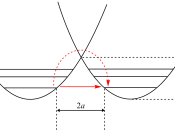Energy
Energy - the ability to do work (move matter)
2 types: Kinetic Energy - energy doing work
ex: heat (moving molecules)
light
Potential EnergyÃÂÃÂ - stored energy; can be as a result of
location or arrangement
ex: roller coaster - at 100 ft high there is more
potential energy than at 25 ft high
cells - molecules have potential energy due to the arrangement of the atoms
Chemical Energy - potential energy of molecules important for living organisms
Thermodynamics
Thermodynamics - study of energy transformations in matter
1st Law of Thermodynamics: Energy cannot be created or
destroyed only transferred or transformed
ex: electric company doesn't create energy, it converts it to a useable form; car converts gasoline (potential energy) into kinetic energy; we convert food into kinetic energy
2nd Law of Thermodynamics: Energy conversions reduce order in the universe (when energy is converted into another form, there is an increase in disorder or randomness)
Entropy - the amount of disorder in a system
Heat is a form of disorder (random molecular motion)
ex 1: fuel in tank of car - all of the chemical energy that is
converted into kinetic energy will eventually be
converted into heat energy.
When stopping car, the
friction between the tires and the road and the brakes
and the tires creates heat.
ex 2: Cells - creates ordered structures from less organized ones (ex: formation of proteins) but surroundings
become less organized because some energy escapes as heat
**Work of cells is powered by the potential energy contained in molecules
Problem: Describe the energy transformations that occur when you climb to the top of a stairway.
Chemical Reactions Either Store or Release Energy
Endergonic Reactions - (energy in)
- Requires an INPUT of energy for the reaction to happen
- Produce products that...


